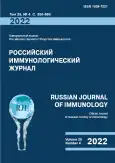Complicated ways of diagnosing common variable immune deficiency (case report)
- Authors: Moskalets O.V.1
-
Affiliations:
- M. Vladimirskiy Regional Research Clinical Institute
- Issue: Vol 25, No 4 (2022)
- Pages: 461-464
- Section: SHORT COMMUNICATIONS
- URL: https://journals.rcsi.science/1028-7221/article/view/120084
- DOI: https://doi.org/10.46235/1028-7221-1173-CWO
- ID: 120084
Cite item
Full Text
Abstract
Common variable immunodeficiency (CVID) is one of the most frequent forms of primary immunodeficiencies with predominant antibody deficiency. Unlike most other primary immunodeficiencies, this variant often manifests in adults thus creating certain difficulties in its detection. Manifestations of common variable immune deficiency are very diverse: infectious syndrome (respiratory tract infections, septic arthritis), diarrheal clinical pattern of both infectious and non-infectious genesis, autoimmune syndrome (autoimmune cytopenias, systemic rheumatic diseases), lymphoproliferative syndrome (benign lymphoid proliferation, lymphomas), interstitial lung disease and sarcoidosis-like granulomatous changes are quite common. Due to the lack of a distinct clinical pattern, the common variable immunodeficiency is often diagnosed too late. Such patients are observed for a long time by various specialists, and the absence of pathogenetic therapy (intravenous immunoglobulins) leads to steady progression of the disease and, often, to lethal outcome. The article presents a clinical observation illustrating the difficulties in making this diagnosis. A woman hospitalized with pneumonia presented with a mass in colonic submucosa. After excluding tuberculosis and lymphoma, a diagnosis of colon lipoma was made on the basis of histological examination. A few years later, the patient’s submandibular lymph nodes were periodically enlarged. Upon repeated histological examination, the diagnosis of granulomatous necrotizing lymphadenitis was established, the patient was referred to a rheumatologist to rule out systemic vasculitis. This diagnosis was not confirmed, but further examination revealed a sharp decrease in the gamma fraction of serum proteins. Therefore, an immunologist’s counseling was recommended to rule out immunodeficiency. The following blood serum analysis revealed an extremely low IgG and IgM content, with absence of detectable immunoglobulin A. On the basis of these findings, the diagnosis of common variable immune deficiency was made for the first time. Replacement therapy with high-dose intravenous immunoglobulins with control of pre-transfusion Ig levels was recommended, with further transition to a supporting treatment schedule. Hence, one may state that general practitioners are still poorly aware of primary immunodeficiencies, especially if non-infectious manifestations dominating in the clinical pattern. Routine analysis of total protein content and protein fractions can provide information that allows to suspect deficiency of antibodies and, therefore, to assess contents of distinct serum immunoglobulins in order to confirm CVID diagnosis.
Full Text
##article.viewOnOriginalSite##About the authors
O. V. Moskalets
M. Vladimirskiy Regional Research Clinical Institute
Author for correspondence.
Email: 6816000@mail.ru
PhD (Medicine), Leading Research Associate, Laboratory of Biomedical Studies
Russian Federation, MoscowReferences
- Abbot K.J., Gelfland E.W. Common variable immunodeficiency: diagnosis, management and treatment. Immunol. Allergy Clin. North Am., 2015, Vol. 35, no. 4, pp. 637-658.
- Ameratunga R., Allan C., Woon S.T. Defining common variable immunodeficiency disorders in 2020. Immunol. Allergy Clin. North. Am., 2020, Vol. 40, no. 3, pp. 403-420.
- Azizi G., Adolhassani H., Asgardoon M.H., Alinia T., Yazdani R., Mohammadi J., Resaei N., Ochs H.D., Aghamohammadi A. Autoimmunity in common variable immunodeficiency: epidemiology, pathophysioliogy and management. Expert Rev. Clin. Immunol., 2017, Vol. 13, no. 2, pp. 101-115.
- Dimitrova A., Jensen M.D., Bock K., Hilberg O. CVID is a multifaced disease. Ugeskr. Laeger, 2018, Vol. 180, no. 47, V02180105. (In Danish)
- Kokron C.M., Errante P.R., Barros M.T., Baracho G.V., Camargo M.M., Kalil J., Rizzo L.V. Clinical and laboratory aspects of common variable immunodeficiency. An. Acad. Bras. Cienc., 2004, Vol. 76, no. 4, pp. 707-726.
- Maglione P.J. Autoimmune and lymphoproliferative complications of common variable immunodeficiency. Curr. Allergy Asthma Rep., 2016, Vol. 16, no. 3, 19. doi: 10.1007/s11882-016-0597-6.
- Park J.H., Levinson A.I. Granulomatous-lymphocytic interstitial lung disease (GLILD) in common variable immunodeficiency (CVID). Clin. Immunol., 2010, Vol. 134, no. 2, pp. 97-103.
Supplementary files







